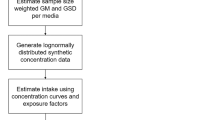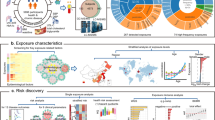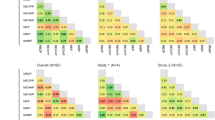Abstract
In 2007, we published a paper in the Journal of Exposure Science and Environmental Epidemiology describing PCDD/F and dioxin-like PCB serum concentration data collected for the 2001–2002 National Health and Nutrition Examination Survey. Since publication of this paper, several of the 1998 World Health Organization Toxic Equivalency Factors (TEFs), which were used to calculate the summary statistics we presented, have been changed. In this addendum, we publish new reference statistics using the WHO2006 TEFs in addition to assessing the effect of these new TEFs on total TEQ concentrations for the general US population. We also examined the effect of the limits of detection (LODs) on the calculated TEQ summary statistics for the top seven contributing congeners and completed a missing data analysis to determine whether our estimates were biased by excluding individuals without complete congener profiles. Similar to our previous results, 2, 3, 7, 8-TCDD; 1, 2, 3, 7, 8-PeCDD; 1, 2, 3, 6, 7, 8-HxCDD; 2, 3, 4, 7, 8-PeCDF; and PCB 126 contributed the most to total TEQ. However, both PCB 156 and 157 were no longer significant contributors, instead being displaced by 1, 2, 3, 4, 7, 8-HxCDF, and PCB 169. In general, the decrease in TEFs for the mono-ortho-substituted PCBs decreased their contribution to total TEQ appreciably, causing TEQ17-9 to approximately equal TEQ17-3. The effect of LODs for five of the top seven contributing congeners was negligible; however, the LODs for 2, 3, 7, 8-TCDD and 1, 2, 3, 7, 8-PeCDD were noticeably higher and may impact TEQ estimates primarily for individuals aged 20–29 years. Results from the missing data analysis provide compelling evidence that the summary statistics we reported previously, as well as those described here, were not greatly influenced due to censoring data.
This is a preview of subscription content, access via your institution
Access options
Subscribe to this journal
Receive 6 print issues and online access
$259.00 per year
only $43.17 per issue
Buy this article
- Purchase on Springer Link
- Instant access to full article PDF
Prices may be subject to local taxes which are calculated during checkout



Similar content being viewed by others
References
Ferriby L.L., Knutsen J.S., Harris M., Unice K.M., Scott P., Nony P., Haws L.C., and Paustenbach D. Evaluation of PCDD/F and dioxin-like PCB serum concentration data from the 2001–2002 National Health and Nutrition Examination Survey of the United States population. J Expo Sci Environ Epidemiol 2007: 17: 358–371.
Haws L.C., Su S.H., Harris M., Devito M.J., Walker N.J., Farland W.H., Finley B., and Birnbaum L.S. Development of a refined database of mammalian relative potency estimates for dioxin-like compounds. Toxicol Sci 2006: 89: 4–30.
NCHS (National Center for Health Statistics). National Health and Nutrition Examination Survey Data. US Department of Health and Human Services, Centers for Disease Control and Prevention, Hyattsville, MD, 2005a.
NCHS (National Center for Health Statistics). Third National Report on Human Exposure to Environmental Chemicals. US Department of Health and Human Services, Centers for Disease Control and Prevention, National Center for Environmental Health, Atlanta, GA, 2005b NCEH Pub. No. 05-0579.
NRC (National Research Council). Human Biomonitoring for Environmental Chemicals. National Research Council, Committee on Human Biomonitoring for Environmental Toxicants. National Academies Press, Washington, DC, 2006.
Paustenbach D., and Galbraith D. Biomonitoring and biomarkers: exposure assessment will never be the same. Environ Health Perspect 2006a: 114: 1143–1149.
Paustenbach D., and Galbraith D. Biomonitoring: is body burden relevant to public health? Regul Toxicol Pharmacol 2006b: 44: 249–261.
Van den Berg M., Birnbaum L.S., Denison M., De Vito M., Farland W., Feeley M., Fiedler H., Hakansson H., Hanberg A., Haws L., Rose M., Safe S., Schrenk D., Tohyama C., Tritscher A., Tuomisto J., Tysklind M., Walker N., and Peterson R.E. The 2005 World Health Organization Reevaluation of Human and Mammalian Toxic Equivalency Factors for Dioxins and Dioxin-Like Compounds. Toxicol Sci 2006: 93: 223–241.
Acknowledgements
Funding for these analyses was provided in part by Southwire Company. Additional funding was provided by ChemRisk Inc. One, or more, of the authors has served as an expert witness in litigation involving exposure to PCDD/Fs and dioxin-like PCBs.
Author information
Authors and Affiliations
Corresponding author
Rights and permissions
About this article
Cite this article
Scott, L., Unice, K., Scott, P. et al. Addendum to: Evaluation of PCDD/F and dioxin-like PCB serum concentration data from the 2001–2002 National Health and Nutrition Examination Survey of the United States population. J Expo Sci Environ Epidemiol 18, 524–532 (2008). https://doi.org/10.1038/jes.2008.10
Received:
Accepted:
Published:
Issue Date:
DOI: https://doi.org/10.1038/jes.2008.10



